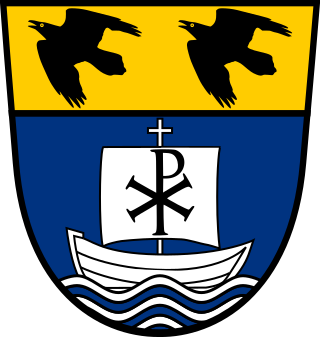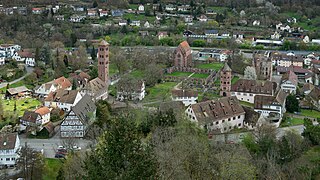Einsiedeln is a municipality and district in the canton of Schwyz in Switzerland known for its monastery, the Benedictine Einsiedeln Abbey, established in the 10th century.

Saint Meinrad Archabbey is a Catholic monastery in Spencer County, Indiana, US, was founded by monks from Einsiedeln Abbey in Switzerland on March 21, 1854, and is home to approximately 79 monks. The Saint Meinrad Seminary and School of Theology is also located on the premises.

Subiaco Abbey is an American Benedictine monastery located in the Arkansas River valley of Logan County, Arkansas, part of the Swiss-American Congregation of Benedictine monasteries. It is home to thirty-nine Benedictine monks. The abbey and the preparatory school it operates, Subiaco Academy, are major features of the town of Subiaco, Arkansas. It is named after the original Subiaco, Italy, where the first monastery founded by Saint Benedict was located.

Hirsau Abbey, formerly known as Hirschau Abbey, was once one of the most important Benedictine abbeys of Germany. It is located in the Hirsau borough of Calw on the northern slopes of the Black Forest mountain range, in the present-day state of Baden-Württemberg. In the 11th and 12th century, the monastery was a centre of the Cluniac Reforms, implemented as "Hirsau Reforms" in the German lands by William of Hirsau. The complex was devastated during the War of the Palatine Succession in 1692 and not rebuilt. The ruins served as a quarry for a period of time.

Benediktbeuern Abbey is an institute of the Salesians of Don Bosco, originally a monastery of the Benedictine Order, in Benediktbeuern in Bavaria, near the Kochelsee, 64 km south-south-west of Munich. It is the oldest and one of the most beautiful monasteries in Upper Bavaria. It was badly damaged in an extreme weather event in 2023.

Meinrad, OSB was a German Benedictine hermit and is revered as a Catholic and Orthodox saint. He is known as the "Martyr of Hospitality". His feast day is 21 January.
Münsterschwarzach Abbey, is a monastery for Benedictine monks in Germany. It is located at the confluence of the rivers Schwarzach and Main in Bavaria.
Blue Cloud Abbey was an American Benedictine monastery located near the town of Marvin, in Grant County, South Dakota. It was a member of the Swiss-American Congregation. The patron saint of the monastery was the Blessed Virgin Mary under the title of Our Lady of the Snows, from which the abbey derived its name.

Mariastein Abbey is a Benedictine monastery in Metzerlen-Mariastein in the Canton of Solothurn, Switzerland.

Fischingen Abbey, now Fischingen Priory, is a Benedictine monastery situated in Fischingen in the Canton of Thurgau, Switzerland, on the upper reaches of the Murg, a tributary of the Thur. It was founded in 1138, dissolved in 1848 and re-founded as a priory in 1977.

St. Georgenberg Abbey is a Benedictine monastery, the oldest extant monastery in the Tyrol, founded in 1138 but from 1708 to 2019 removed to the nearby city of Fiecht in the community of Vomp in Tyrol, Austria. In 2019 the monks returned to a restored abbey at St. Georgenberg, which had remained a place of pilgrimage and spiritual retreat.

Conception Abbey, site of the Basilica of the Immaculate Conception, is a monastery of the Swiss-American Congregation of the Benedictine Confederation. The monastery, founded by the Swiss Engelberg Abbey in 1873 in northwest Missouri's Nodaway County, was raised to a conventual priory in 1876 and elevated to an abbey in 1881. In 2021 the community numbered fifty-eight monks who celebrate the Eucharist and Liturgy of the Hours daily and who staff and administer Conception Seminary College, The Printery House, and the Abbey Guest Center. Monks also serve as parish priests and hospital chaplains in the Diocese of Kansas City-Saint Joseph and other dioceses. There is also a large postal facility attached to The Printery House, operated by lay employees, which includes package shipping and delivery facilities.

Maria Rickenbach Monastery is a Benedictine monastery of Religious Sisters. It is situated in the village of Niederrickenbach in the municipality of Oberdorf in the Swiss canton of Nidwalden. It is accessible to the public only by cable car from Niederrickenbach Station on the Luzern–Stans–Engelberg railway line, although there is a private road leading up to the village from Dallenwil.

Benno Gut was a Benedictine monk of the Archabbey of Maria Einsiedeln, Switzerland, and a cardinal of the Roman Catholic Church. He served as prefect of the Congregation for Divine Worship in the Roman Curia from 1969 until his death, and was elevated to the cardinalate in 1967.

Martin Marty was a Swiss-born Benedictine missionary and Catholic bishop in the United States.

Fintan Mundwiler was a Swiss Benedictine, who became Abbot of St. Meinrad Abbey, Indiana.

Fahr Convent is a Benedictine convent located in an exclave of the canton of Aargau, surrounded by the municipality of Unterengstringen. It is located 8 km to the north of Zürich's city centre. Located in different cantons, Einsiedeln Abbey and Fahr Convent form a double monastery, overseen by the male Abbot of Einsiedeln, no converse arrangement appears to be available for the Abbess of Fahr. Fahr and Einsiedeln may be one of the last of such arrangements to survive.

The Swiss-American Congregation is an association of Benedictine monasteries founded in 1881 in the United States, as a part of the international Benedictine Confederation of monasteries.

Wolfgang Schlumpf was a Swiss-born Benedictine monk and missionary in the United States who is credited as founder of Subiaco Abbey in western Arkansas. He immigrated to the United States in 1862 after being assigned to what became St. Meinrad Abbey in 1870 in southern Indiana..

Ignatius Conrad was a Benedictine monk, a Swiss missionary, and the first Abbot of Subiaco Abbey in Arkansas, which was named as an abbey in 1891. He served from 1892 to 1925. Fr Ignatius Conrad initially worked with the German Catholic communities in the south-western region of the United States.


























